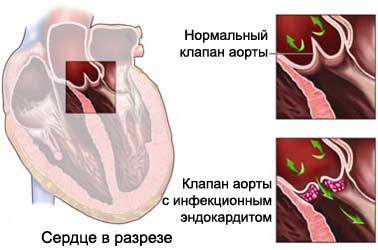Bacterial endocarditis – Infective endocarditis
Description bacterial endocarditis
Endocardium is a thin membrane, which covers the inner surface of the heart. Bacterial endocarditis – infection of the membrane. Infection occurs, where the bacteria enter the membrane and multiply in it.
The greatest risk of infection occurs, when the heart or valves have already damaged. This condition can be life threatening and can permanently disrupt the normal operation of the heart valves. It can also cause serious health problems, such as congestive heart failure.
The infection can cause growths on the valves or other areas of the heart. Parts of these growths can break off and enter the bloodstream to other parts of the body. This can lead to serious complications.

Causes of bacterial endocarditis
Bacteria can enter the heart through blood infection elsewhere in the body, eg actions, that cause breaks in the skin or mucous membranes (dental procedures, operation, administering medication through the IV). Bacterial Endocarditis cause only some bacteria. The most common are:
- Streptokokki;
- Staphylococci;
- Enterococci.
After entering the bacteria begin to multiply endocardium. Some of heart disease may increase the likelihood of infection. They can obstruct blood flow, which provides favorable conditions for the growth of harmful bacteria.
Risk factors for infective endocarditis
Conditions, causing an increased risk of infective endocarditis:
- Scarring of the heart valves due to rheumatic fever or other diseases;
- Artificial heart valves;
- Congenital heart disease;
- Cardiomyopathy;
- The previous case of endocarditis;
- Mitral valve prolapse, with significant regurgitation (abnormal regurgitation).
The above disorders increase the risk of infection during certain procedures:
- The introduction of drugs through an IV; the risk is very high, When using reusable needle;
- Any dental procedures;
- Tonsillectomy or adenoids, and other procedures on the ears, nose and throat;
- Bronchoscopy (check the airway through a thin tube);
- Operation on the gastro-intestinal tract or urinary tract, operations including gall bladder and prostate.
The symptoms of infective endocarditis
Symptoms range from mild to severe, depending on the:
- Bacteria, causing infection;
- Number of bacteria in the blood;
- Extent of structural heart defects;
- The body's ability to fight infection;
- General health.
Symptoms, which may occur within two weeks after exposure of bacteria into the bloodstream:
- Fever;
- Chills;
- Fatigue;
- Weakness;
- Malaise;
- Unexplained weight loss;
- Poor appetite;
- Muscle aches;
- Joint pain;
- Cough;
- Breathlessness;
- Small red dots on the skin, in the mouth, and / or under the nails;
- Cones on the fingers and toes;
Sometimes the initial symptoms may be caused by the separation of the infected heart. These may include complications of stroke and other organs.
Diagnosis of infectious endocarditis
The doctor will ask about your symptoms and medical history, and perform a physical examination. The heart will be heard to find extraneous noise.
Tests may include:
- Blood cultures to test for the presence of bacteria;
- Blood test – It indicates the signs of infection and complications, associated with endocarditis;
- CT – such as X-rays, which uses computer, to take pictures inside the chest;
- Electrocardiogram – test, that records heart activity by measuring electrical current through the heart muscle;
- Echocardiogram– test, which uses high-frequency sound waves (ultrasound), to examine the size, shape and motion of the heart;
- Transesophageal echocardiography – an ultrasonic probe is inserted through the mouth into the esophagus, to study heart valves.
Treatment of infective endocarditis
Treatment is focused on the removal of infection from the blood and heart.
Medication
Through a drip into a vein introduced antibiotics. This type of treatment is carried out in the hospital and can go on for 4-6 weeks.
Operation
Antibiotics can not completely eradicate the bacteria and can cause recurrent infections. In this case, the operation may be necessary.
Surgery may be needed, if the heart valves are damaged or infection.
Prevention of infective endocarditis
The best way to prevent endocarditis – take precautions with intravenous drugs. Some of heart disease may increase the risk of infection.
People with very high risk should take antibiotics before and after certain dental and medical procedures.
Besides:
- Tell the dentist before the procedure, if you have heart disease;
- Maintain good oral hygiene:
- Brush your teeth twice a day;
- Floss daily;
- See your dentist for cleaning plaque at least once every six months;
- Consult your dentist, If the prosthesis causes discomfort;
- Seek immediate medical attention after the emergence of symptoms of infection.
